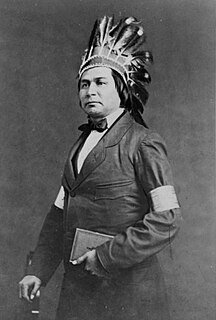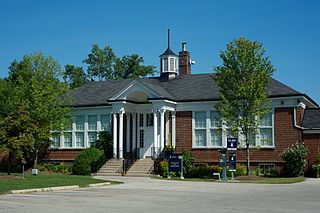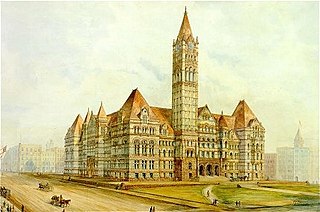
The Mississauga are a subtribe of the Anishinaabe-speaking First Nations people located in southern Ontario, Canada. They are closely related to the Ojibwe. The name "Mississauga" comes from the Anishinaabe word Misi-zaagiing, meaning "[Those at the] Great River-mouth." It is closely related to the Ojibwe word Misswezahging, which means ‘a river with many outlets.’

Adolphus Egerton Ryerson (1803–1882) was a Canadian Methodist minister, educator, politician, and public education advocate in Upper Canada. He was a prominent opponent of the closed oligarchy that ran the province, calling it the Family Compact. Ryerson University is named after him.

Port Credit is a neighbourhood in the south-central part of the City of Mississauga, Ontario, Canada, located at the mouth of the Credit River on the north shore of Lake Ontario. Its main intersection is Hurontario Street and Lakeshore Road, about 0.6 km. east of the river. Until 1974, Port Credit was an incorporated town. Its approximate boundaries are the Canadian National Railway to the north, Seneca Avenue to the east and Shawnmarr Road to the west. It had a population of 10,260 at the 2001 census.
Saugeen First Nation is an Ojibway First Nation band located along the Saugeen River and Bruce Peninsula in Ontario, Canada. The band states that their legal name is the "Chippewas of Saugeen". Organized in the mid-1970s, Saugeen First Nation is the primary "political successor apparent" to the Chippewas of Saugeen Ojibway Territory; the other First Nation that is a part of Chippewas of Saugeen Ojibway Territory is Cape Croker. The Ojibway are of the Algonquian languages family. The First Nation consist of four reserves: Chief's Point 28, Saugeen 29, Saugeen Hunting Grounds 60A, and Saugeen and Cape Croker Fishing Islands 1.

George Copway was a Mississaugas Ojibwa writer, ethnographer, Methodist missionary, lecturer, and advocate of indigenous peoples. His Ojibwa name was Kah-Ge-Ga-Gah-Bowh, meaning "He Who Stands Forever". In 1847 he published a memoir about his life and time as a missionary. This work made him Canada's first literary celebrity in the United States. In 1851 he published The Traditional History and Characteristic Sketches of The Ojibway Nation, the first published history of the Ojibwa in English.
Nahnebahwequa or Catherine Bunch was an Ojibwa spokeswoman and Christian Missionary.

The Wiikwemkoong First Nation is a First Nation on Manitoulin Island in Northern Ontario. The Wiikwemkoong Unceded Territory is the First Nation reserve in the north-eastern section of Manitoulin Island in Manitoulin District, Ontario, Canada. Wiikwemkoong is an unceded Indigenous reserve in Canada, which means that it has not "relinquished title to its land to the government by treaty or otherwise."

Erindale is an historical neighbourhood located within the central part of the city of Mississauga, west of Toronto, Ontario, Canada. Erindale is named in honour of the birthplace of the first rector of the village, Reverend James Magrath from Erin (Ireland).

Peter Jones was an Ojibwe Methodist minister, translator, chief and author from Burlington Heights, Upper Canada. His Ojibwa name was Kahkewāquonāby, which means "[Sacred] Waving Feathers". In Mohawk, he was called Desagondensta, meaning "he stands people on their feet". In his youth his band of Mississaugas had been on the verge of destruction. As a preacher and a chieftain, as a role model and as a liaison to governments, his leadership helped his people survive contact with Europeans.

Mississaugas of the Credit First Nation is a Mississauga Ojibwa First Nation located near Brantford in south-central Ontario, Canada. In April 2015, MCFN had an enrolled population of 2,330 people, 850 of whom lived on the MCFN Reserve. The first nation governs the 2,392.6-hectare parcel of New Credit 40A Indian Reserve known as Reserve 40B near Hagersville, Ontario. This reserve is located near the Six Nations of the Grand River in Brantford.

The Toronto Purchase was the surrender of lands in the Toronto area from the Mississaugas of New Credit to the British crown. An initial, disputed, agreement was made in 1787, in exchange for various items. The agreement was revisited in 1805, intended to clarify the area purchased. The agreement remained in dispute for over 200 years until 2010, when a settlement for the land was made between the Government of Canada and the Mississaugas for the land and other lands in the area.

Enoch Moore, son of Samuel Moore U.E. and Rachel Stone, married Elizabeth Smith, daughter of James Smith and Hannah Hawksworth, on March 30, 1803 in Old Holy Trinity Church, Lower Middleton, Annapolis County, Nova Scotia. Elizabeth was born on April 18, 1784 in Wilmot Township, NS, died on March 3, 1871 and was buried in New Milford Cemetery, Winnebago County, Illinois. Enoch was a direct descendant of one of New Jersey's early colonial officials, Samuel Moore.

Augustus Jones was an American-born Upper Canadian farmer, land speculator, magistrate, militia captain and surveyor. Jones trained as a surveyor in New York City, and fled as a United Empire Loyalist to Upper Canada. In Upper Canada, he worked as a crown surveyor in the Nassau District, where he quickly rose to the position of Deputy Surveyor General, the highest position in a district of Upper Canada. He occupied that position from 1789 informally, and 1791 formally, until his retirement in 1799. During that time he laid down many of the township boundaries in the Niagara Peninsula and on the north shore of Lake Ontario. He led various teams that cut many of the first sideroads and concession roads into these areas, facilitating their settlement by European and American immigrants. Jones also surveyed the routes for Dundas Street and Yonge Street, and supervised their construction. After his retirement, Jones farmed first in Saltfleet Township, later moving to Brantford and finally an estate outside Paris named Cold Springs, where he died in 1836.
John Cameron, also known as Ogimauh-binaessih (from the Anishinaabe language: Ogimaa-binesiinh, "chief little-bird") or Wageezhegome, was one of two principal Indigenous Mississauga Ojibwa chiefs, member of the eagle doodem, and farmer. He was born at Credit River, Ontario, and died at the Credit Mission (Mississauga), Upper Canada.

Colonel James Givins was a British Army officer and militiaman who fought in the American Revolution and the War of 1812. He was also an Indian agent of Upper Canada, rising to Chief Superintendent of the Indian Department. He is the namesake of Givins Street in Toronto.
John Jones, also known as Thayendanegea in Ojibwe, was a Mississauga Ojibwa teacher, missionary and Chief.
Tuhbenahneequay (1780–1873) was a Mississauga woman from the Burlington Heights area of Upper Canada. The daughter of chief Wahbanosay and Puhgashkish, she married Augustus Jones in a Mississauga ceremony sometime in the 1790s. Their first child, Thayendanegea, was born in 1798. The same year, Jones married another woman, Sarah Tekarihogen, in a Christian ceremony. Polygamy was an acceptable practice among the Mississaugas, and Jones lived with Tekarihogen at his farm in Stoney Creek and with Tuhbenahneequay as his wife while surveying. Tuhbenahneequay was baptised Sarah Henry by an American Methodist circuit-rider in 1801. She was the first Mississauga woman baptised a Methodist. Despite her baptism, she refused to become a Christian. Her second child by Augustus Jones, Kahkewaquonaby, later known as the missionary Peter Jones, was born in 1802. The same year, Jones ended his relationship with Tuhbenahneequay as he wanted the respect of his white Christian neighbours and Tuhbenahneequay refused to convert. Both children were left with Tuhbenahneequay.
Thomas Davis was a Mohawk war chief. In Mohawk he was called Tehowagherengaraghkwen.

Peter Edmund Jones M.D. was a Mississauga Ojibwa chief of New Credit. In Ojibwe he was called Kahkewaquonaby, named after his father in two languages.
Joseph Ryerson was a United Empire Loyalist, Lieutenant in the Prince of Wales American Volunteers in the American Revolutionary War, a Lieutenant-Colonel Commanding the First Regiments of the Norfolk Militia in the War of 1812 and father of Egerton Ryerson. Ryerson was a descendant of Dutch immigrants who held judicial appointments to King George II and King George III.













